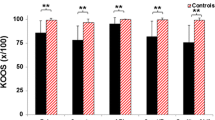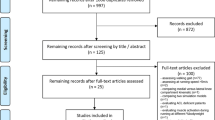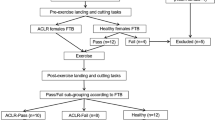Abstract
Purpose
Poor knee function after anterior cruciate ligament reconstruction (ACLR) may increase the risk of future knee symptoms and knee osteoarthritis via abnormal knee joint loading patterns, particularly during high-impact activity. This study aimed to assess the relationship between poor self-reported or clinically measured knee function and knee moments/vertical ground reaction force (vGRF) in individuals following ACLR.
Methods
61 participants (mean 16.5 ± 3 months following ACLR, 23 women) completed a patient-reported knee function questionnaire and three hop tests (% of uninvolved limb). Participants were divided into satisfactory and poor knee function groups (poor < 85% patient-reported knee function and/or < 85% hop test symmetry). The knee biomechanics of both groups were assessed with three-dimensional motion analysis during the stance phase of overland running at self-selected speeds, and the association between knee function and knee moments was assessed using analysis of covariance with running speed as a covariate.
Results
Participants with poor knee function (n = 30) ran with significantly smaller peak knee flexion moments (moderate effect size 0.7, p = 0.03) and significantly smaller peak vGRFs (large effect size 1.0, p = 0.002) compared to those with satisfactory knee function (n = 31). No significant differences were observed for knee adduction and knee external rotation moments or knee kinematics.
Conclusion
Individuals following ACLR with poor self-reported knee function and/or hop test performance demonstrate knee moments during running that may be associated with lower knee joint contact forces. These findings provide greater understanding of the relationship between knee biomechanics during running and clinical assessments of knee function.
Level of evidence
III. Cross-sectional study.
Similar content being viewed by others
References
Filbay SR, Ackerman IN, Russell TG, Macri EM, Crossley KM (2014) Health-related quality of life after anterior cruciate ligament reconstruction: a systematic review. Am J Sports Med 42:1247–1255
Glyn-Jones S, Palmer A, Agricola R, Price A, Vincent T, Weinans H et al (2015) Osteoarthritis The Lancet 386:376–387
Saxby DJ, Bryant AL, Modenese L, Gerus P, Killen B, Konrath J et al (2016) Tibiofemoral contact forces in the anterior cruciate ligament-reconstructed knee. Med Sci Sports Exerc 48:2195–2206
Wellsandt E, Gardinier ES, Manal K, Axe MJ, Buchanan TS, Snyder-Mackler L (2016) Decreased knee joint loading associated with early knee osteoarthritis after anterior cruciate ligament injury. Am J Sports Med 44:143–151
Dye SF (1998) Factors contributing to function of the knee joint after injury or reconstruction of the anterior cruciate ligament. J Bone Jt Surg Am 80:1380
Culvenor A, Perraton L, Guermazi A, Bryant A, Whitehead T, Morris H et al (2016) Knee kinematics and kinetics are associated with early patellofemoral osteoarthritis following anterior cruciate ligament reconstruction. Osteoarthr Cartil 24:1548–1553
Culvenor AG, Schache AG, Vicenzino B, Pandy MG, Collins NJ, Cook JL et al (2014) Are knee biomechanics different in those with and without patellofemoral osteoarthritis after anterior cruciate ligament reconstruction? Arthritis Care Res 66:1566–1570
Hart HF, Culvenor AG, Collins NJ, Ackland DC, Cowan SM, Machotka Z et al (2015) Knee kinematics and joint moments during gait following anterior cruciate ligament reconstruction: a systematic review and meta-analysis. Br J Sports Med 50:597–612
Sigward SM, Lin P, Pratt K (2016) Knee loading asymmetries during gait and running in early rehabilitation following anterior cruciate ligament reconstruction: A longitudinal study. Clin Biomech 32:249–254
Kuenze C, Hertel J, Weltman A, Diduch DR, Saliba S, Hart JM (2014) Jogging biomechanics after exercise in individuals with ACL-reconstructed knees. Med Sci Sports Exerc 46:1067–1076
Lewek M, Rudolph K, Axe M, Snyder-Mackler L (2002) The effect of insufficient quadriceps strength on gait after anterior cruciate ligament reconstruction. Clin Biomech 17:56–63
Noehren B, Wilson H, Miller C, Lattermann C (2013) Long term gait deviations in anterior cruciate ligament reconstructed females. Med Sci Sports Exerc 45:1340
Bush Joseph CA, Hurwitz DE, Patel RR, Bahrani Y, Garretson R, Bach BR et al (2001) Dynamic function after anterior cruciate ligament reconstruction with autologous patellar tendon. Am J Sports Med 29:36–41
Kline PW, Johnson DL, Ireland ML, Noehren B (2015) Clinical predictors of knee mechanics at return to sport following ACL reconstruction. Med Sci Sports Exerc 48:790
Øiestad B, Juhl C, Eitzen I, Thorlund J (2015) Knee extensor muscle weakness is a risk factor for development of knee osteoarthritis. A systematic review and meta-analysis. Osteoarthr Cartil 23:171–177
Hall M, Bryant AL, Wrigley TV, Pratt C, Crossley KM, Whitehead TS et al (2015) Does meniscal pathology alter gait knee biomechanics and strength post-ACL reconstruction? Knee Surg Sports Traumatol Arthrosc 24:1501–1509
Culvenor AG, Collins NJ, Guermazi A, Cook JL, Vicenzino B, Khan KM et al (2015) Early knee osteoarthritis is evident one year following anterior cruciate ligament reconstruction: a magnetic resonance imaging evaluation. Arthritis Rheumatol 67:946–955
Tegner Y, Lysholm J (1985) Rating systems in the evaluation of knee ligament injuries. Clin Orthop Relat Res 198:43–49
Cameron ML, Briggs KK, Steadman JR (2003) Reproducibility and reliability of the outerbridge classification for grading chondral lesions of the knee arthroscopically. Am J Sports Med 31:83–86
Grindem H, Eitzen I, Moksnes H, Snyder-Mackler L, Risberg MA (2012) A pair-matched comparison of return to pivoting sports at 1 year in anterior cruciate ligament–injured patients after a nonoperative versus an operative treatment course. Am J Sports Med 40:2509–2516
Noyes FR, Barber S, Magine R (1991) Abnormal lower limb symmetry determined by function hop tests after anterior cruciate ligament rupture. Am J Sports Med 19:513–518
Barber-Westin SD, Noyes FR, McCloskey JW (1999) Rigorous statistical reliability, validity, and responsiveness testing of the Cincinnati knee rating system in 350 subjects with uninjured, injured, or anterior cruciate ligament-reconstructed knees. Am J Sports Med 27:402–416
Gustavsson A, Neeter C, Thomeé P, Grävare Silbernagel K, Augustsson J, Thomeé R et al (2006) A test battery for evaluating hop performance in patients with an ACL injury and patients who have undergone ACL reconstruction. Knee Surg Sports Traumatol Arthrosc 14:778–788
Reid A, Birmingham TB, Stratford PW, Alcock GK, Giffin JR (2007) Hop testing provides a reliable and valid outcome measure during rehabilitation after anterior cruciate ligament reconstruction. Phys Ther 87:337–349
Ardern CL, Webster KE, Taylor NF, Feller JA (2011) Return to the preinjury level of competitive sport after anterior cruciate ligament reconstruction surgery. Am J Sports Med 39:538–543
Barber SD, Noyes FR, Mangine RE, Hartman W (1990) Quantitative assessment of functional limitations in normal and anterior cruciate ligament-deficient knees. Clin Orthop Relat Res 255:204–214
Clark NC (2001) Functional performance testing following knee ligament injury. Phys Ther Sport 2:91–105
Gokeler A, Welling W, Zaffagnini S, Seil R, Padua D (2016) Development of a test battery to enhance safe return to sports after anterior cruciate ligament reconstruction. Knee Surg Sports Traumatol Arthrosc 25:192–199
Perraton L, Clark R, Crossley K, Pua Y-H, Whitehead T, Morris H et al (2016) Impaired voluntary quadriceps force control following anterior cruciate ligament reconstruction: relationship with knee function. Knee Surg Sports Traumatol Arthrosc 24:1–8
Schache AG, Baker R (2007) On the expression of joint moments during gait. Gait Posture 25:440–452
Perraton L (2014) Neuromuscular control and knee function after anterior cruciate ligament reconstruction (doctoral dissertation). http://hdl.handle.net/11343/46499. 24 Nov 2017
Butler RJ, Dai B, Garrett WE, Queen RM (2014) Changes in landing mechanics in patients following anterior cruciate ligament reconstruction when wearing an extension constraint knee brace. Sports Health 6:203–209
Trigsted SM, Post EG, Bell DR (2017) Landing mechanics during single hop for distance in females following anterior cruciate ligament reconstruction compared to healthy controls. Knee Surg Sports Traumatol Arthrosc 25:1395–1402
Baumeister J, Reinecke K, Schubert M, Weiß M (2011) Altered electrocortical brain activity after ACL reconstruction during force control. J Orthop Res 29:1383–1389
Madhavan S, Shields RK (2011) Neuromuscular responses in individuals with anterior cruciate ligament repair. Clin Neurophysiol 122:997–1004
Chmielewski TL, Zeppieri G Jr, Lentz T, Tillman S, Moser M, Indelicato P et al (2011) Longitudinal changes in psychosocial factors and their association with knee pain and function after anterior cruciate ligament reconstruction. Phys Ther 91:1355–1366
Xergia SA, Pappas E, Georgoulis AD (2014) Association of the single-limb hop test with isokinetic, kinematic, and kinetic asymmetries in patients after anterior cruciate ligament reconstruction. Sports Health 7:217–223
Schmitt LC, Paterno MV, Ford KR, Myer GD, Hewett TE (2015) Strength asymmetry and landing mechanics at return to sport after anterior cruciate ligament reconstruction. Med Sci Sports Exerc 47:1426–1434
Keller T, Weisberger A, Ray J, Hasan S, Shiavi R, Spengler D (1996) Relationship between vertical ground reaction force and speed during walking, slow jogging, and running. Clin Biomech 11:253–259
Mathews SC, Narotsky DL, Bernholt DL, Vogt M, Hsieh Y-H, Pronovost PJ et al (2012) Mortality among marathon runners in the United States, 2000–2009. Am J Sports Med 40:1495–1500
Ardern CL, Taylor NF, Feller JA, Webster KE (2014) Fifty-five per cent return to competitive sport following anterior cruciate ligament reconstruction surgery: an updated systematic review and meta-analysis including aspects of physical functioning and contextual factors. Br J Sports Med 48:1543–1552
Abrams GD, Harris JD, Gupta AK, McCormick FM, Bush-Joseph CA, Verma NN et al (2014) Functional performance testing after anterior cruciate ligament reconstruction: a systematic review. Orthop J Sports Med 2:1–10
Vermesan D, Prejbeanu R, Laitin S, Georgianu V, Haragus H, Nitescu S et al (2014) Meniscal tears left in situ during anatomic single bundle anterior cruciate ligament reconstruction. Eur Rev Med Pharmacol Sci 18:252–256
Grindem H, Snyder-Mackler L, Moksnes H, Engebretsen L, Risberg MA (2016) Simple decision rules can reduce reinjury risk by 84% after ACL reconstruction: the Delaware-Oslo ACL cohort study. Br J Sports Med 50:804–808
Gokeler A, Bisschop M, Myer GD, Benjaminse A, Dijkstra PU, van Keeken HG et al (2016) Immersive virtual reality improves movement patterns in patients after ACL reconstruction: implications for enhanced criteria-based return-to-sport rehabilitation. Knee Surg Sports Traumatol Arthrosc 24:2280–2286
Acknowledgements
We gratefully acknowledge the assistance of Ms. Stacey Telianidis and Ms. Karine Fortin who assisted with data collection. Luke Perraton was a recipient of a National Health and Medical Research Council (NHMRC) postgraduate scholarship (APP1038378). Michelle Hall is supported by a Sir Randal Heymanson Research Fellowship from The University of Melbourne. Adam Bryant and Ross Clark are recipients of NHMRC Career Development Fellowships (R.D.Wright Biomedical, no. 1053521 and 1090415). AC was supported by postdoctoral funding from a European Union Seventh Framework Program (FP7-PEOPLE-2013-ITN; 607510) and is a recipient of an NHMRC Early Career Fellowship (Neil Hamilton Fairley, no. 1121173). The authors have no professional or financial affiliations that may be perceived to have biased the presentation.
Author information
Authors and Affiliations
Corresponding author
Ethics declarations
Conflict of interest
The authors declare that they have no conflict of interest.
Funding
There was no external source of funding for this study.
Ethical approval
Ethical approval was obtained by the University of Melbourne Human Research Ethics committee (ID 1136167). All procedures performed were in accordance with the ethical standards of the institution and the 1964 Declaration of Helsinki and its later amendments.
Informed consent
Informed consent was obtained from all individual participants included in the study.
Rights and permissions
About this article
Cite this article
Perraton, L.G., Hall, M., Clark, R.A. et al. Poor knee function after ACL reconstruction is associated with attenuated landing force and knee flexion moment during running. Knee Surg Sports Traumatol Arthrosc 26, 391–398 (2018). https://doi.org/10.1007/s00167-017-4810-5
Received:
Accepted:
Published:
Issue Date:
DOI: https://doi.org/10.1007/s00167-017-4810-5




